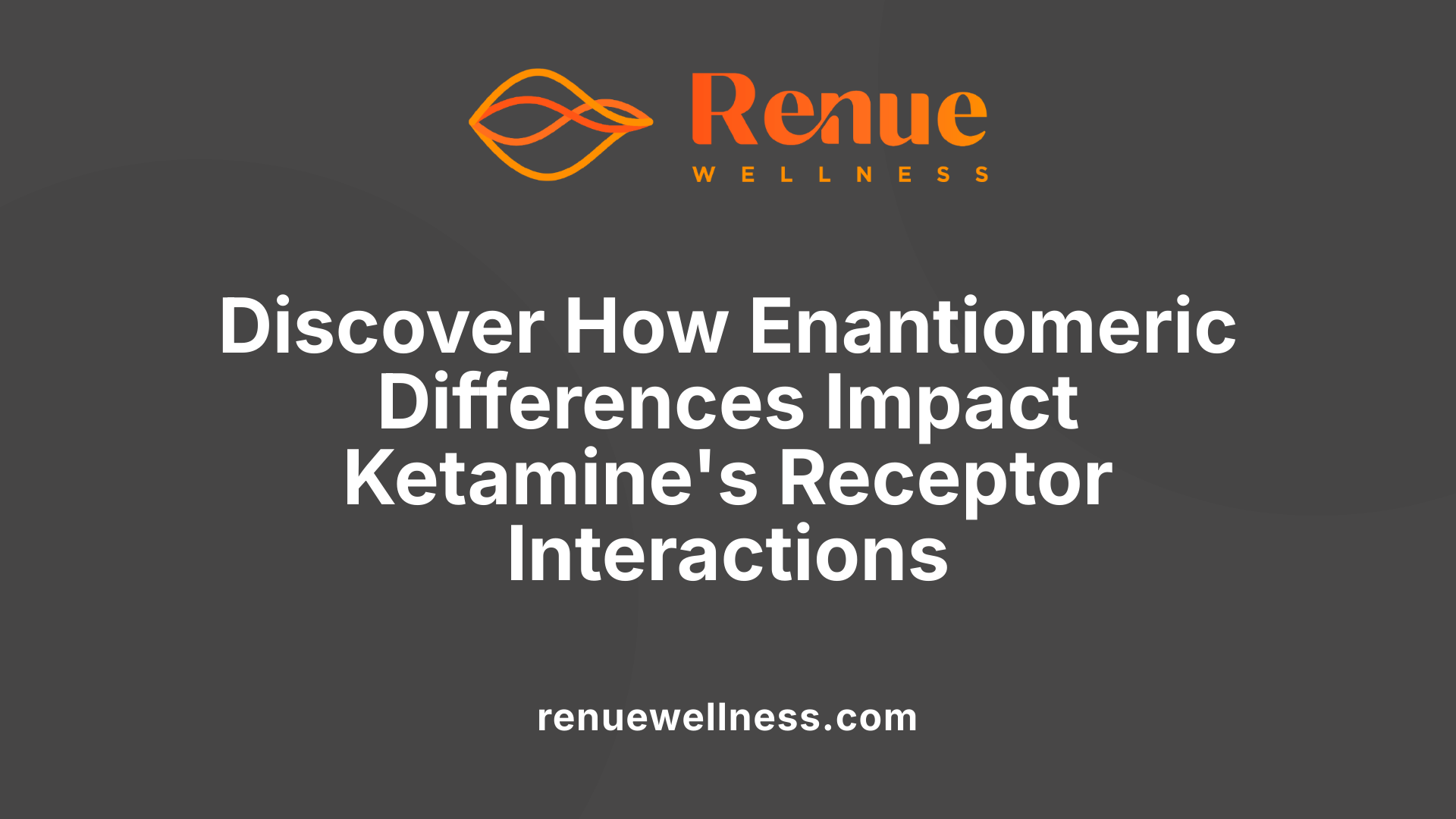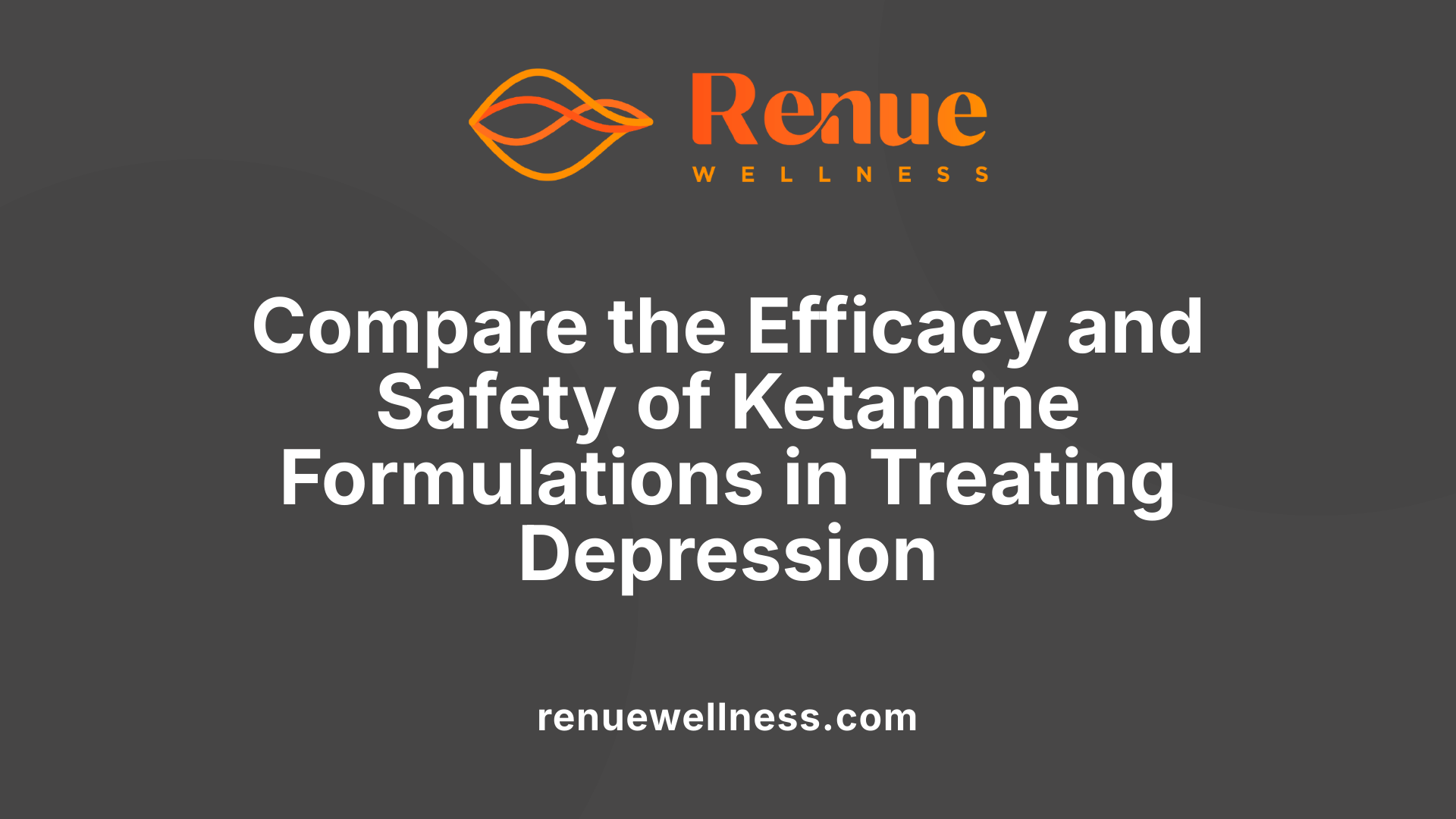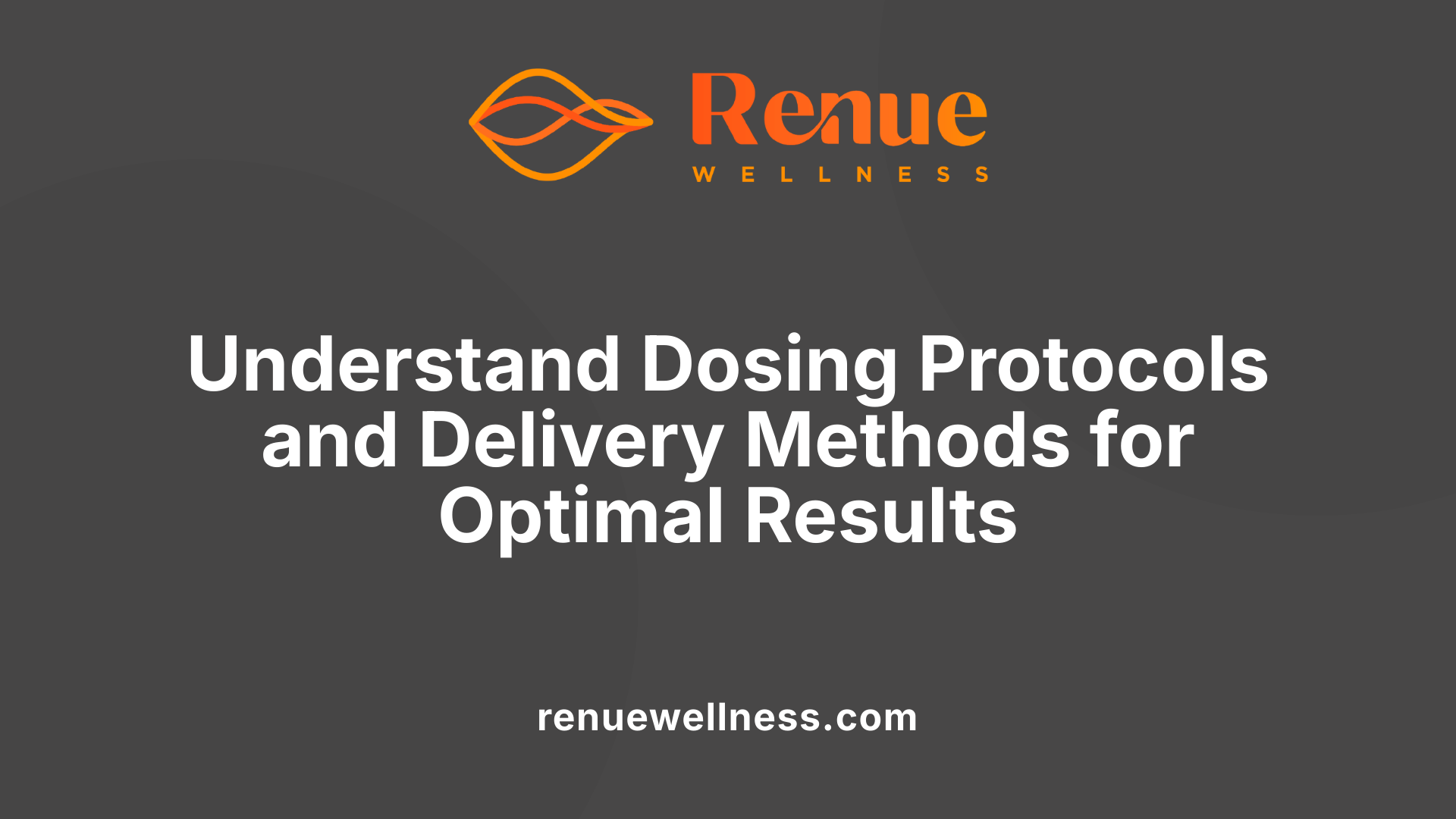Understanding the Difference Between Racemic Ketamine and Esketamine


July 21, 2025
An In-Depth Look at Ketamine's Enantiomers and Their Clinical Significance
Understanding the intricate differences between racemic ketamine and esketamine is crucial for optimized clinical use, especially in mental health disorders. Both substances originate from the same chemical family but differ significantly in their structure, pharmacology, and therapeutic applications. This article delves into their molecular compositions, mechanisms of action, clinical uses, safety profiles, and current regulatory status, providing comprehensive insights for clinicians and patients alike.
Chemical and Structural Differences Between Racemic Ketamine and Esketamine
What are the chemical and structural differences between racemic ketamine and esketamine?
Racemic ketamine is a mixture containing equal parts of two mirror-image molecules known as enantiomers: R-ketamine and S-ketamine (esketamine). These enantiomers are like non-superimposable mirror images, each with a unique three-dimensional structure due to a chiral center in their molecular makeup. This difference in spatial configuration influences how each interacts with brain receptors.
Structurally, both R- and S-ketamine share the same molecular formula, C13H16ClNO, but their 3D arrangements differ because of how their molecules are oriented in space. Esketamine is the purified form of the S-enantiomer, which has been isolated and is used pharmacologically for depression treatment.
The S-enantiomer, esketamine, exhibits approximately four times higher affinity for NMDA receptors than racemic ketamine. This increased receptor binding strength makes esketamine more potent, allowing for lower doses to achieve therapeutic effects. In contrast, R-ketamine, or arketamine, has a different pharmacological profile. It appears to promote neuroplastic changes capable of producing longer-lasting antidepressant effects, with fewer dissociative side effects.
Both enantiomers undergo different metabolic pathways in the brain, contributing to their distinct effects. Esketamine's potent binding and rapid action have made it suitable for nasal spray formulations, especially for treatment-resistant depression. Meanwhile, racemic ketamine, with both enantiomers, is often used in intravenous infusions, leveraging the combined effects of R- and S-forms.
These molecular differences significantly impact their clinical use, where esketamine’s higher potency enables quick, effective treatment with specific supervision, whereas racemic ketamine’s broader activity spectrum is beneficial in various settings, including off-label depressant therapies.
Clinical Uses and Applications of Racemic Ketamine and Esketamine

What are the clinical uses and applications of racemic ketamine and esketamine?
Racemic ketamine has a long-standing history as a dissociative anesthetic used widely in hospitals, veterinary practice, and battlefield medicine since its discovery in the 1960s. Its unique mechanism of action, involving NMDA receptor antagonism and modulation of glutamate neurotransmission, opened new pathways for treating mental health conditions. In recent decades, research uncovered its rapid antidepressant effects, especially in cases of treatment-resistant depression (TRD). Clinicians administer IV racemic ketamine in infusions typically lasting 40 minutes, with a common protocol involving six sessions over three weeks. This off-label use can alleviate depressive symptoms within hours and sustain improvements for days to weeks.
Esketamine, a more targeted derivative of ketamine composed solely of the S-enantiomer, gained FDA approval in 2019 for TRD and depression with suicidal ideation (MDSI). It is delivered via intranasal spray in a supervised clinical setting, following standardized dosing protocols—initial doses around 56 mg twice weekly, with adjustments during maintenance phases. Both formulations work primarily by blocking NMDA receptors, increasing glutamate release, and activating downstream neuroplastic pathways such as BDNF and mTOR, promoting synaptogenesis and mood stabilization.
Apart from depression, both racemic ketamine and esketamine have been utilized in emergency scenarios to rapidly reduce suicidal thoughts, which can be life-threatening if untreated. They also demonstrate efficacy in managing acute mood episodes, post-traumatic stress disorder (PTSD), generalized anxiety, and certain chronic pain syndromes. Their roles as rapid anti-suicidal agents make them invaluable adjuncts during crisis interventions.
Dosing protocols and administration settings
Racemic ketamine is predominantly administered intravenously in medical settings, with infusion protocols involving 0.5 mg/kg over 40 minutes, repeated multiple times over several weeks. Some clinics administer infusions twice weekly or weekly, observing response and adjusting treatment accordingly. The infusion procedure allows for predictable uptake and precise titration. Side effects such as dissociation, hallucinations, increased blood pressure, dizziness, and nausea are common during and shortly after infusion, necessitating medical supervision.
Esketamine, by contrast, is administered as a nasal spray under a REMS (Risk Evaluation and Mitigation Strategy) program. Patients self-administer under supervision, often starting with doses of 56 mg twice weekly for four weeks. Following initial phase, maintenance doses are tailored based on response and tolerability. Because of its less invasive route, esketamine's administration setting is more flexible, appearing in clinics, health centers, or even at home with professional oversight.
Both administration methods require monitoring of vital signs and neuropsychiatric status during and after dosing due to potential side effects. The outpatient setting for esketamine allows for rapid accessibility, whereas IV ketamine’s infusion setup is more resource-intensive but offers more control over dosing.
Comparison of efficacy in depression and other disorders
Numerous clinical trials and systematic reviews suggest that IV racemic ketamine generally demonstrates higher response and remission rates compared to intranasal esketamine. A comprehensive meta-analysis pooling data from 24 randomized controlled trials involving over 1,800 participants found racemic ketamine had a response rate approximately three times greater than placebo and significantly higher remission rates.
In a recent systematic review, racemic ketamine's effect was observed to start within hours of administration, lasting up to a week, with some studies indicating better long-term remission. By contrast, esketamine typically produces rapid symptom reduction within days, with effects often sustained for one to two weeks.
Head-to-head comparisons between IV ketamine and intranasal esketamine are limited, but existing evidence from clinical trials and observational studies suggests IV racemic ketamine may offer a slight edge in efficacy, especially in severe or complex cases.
Side effect profiles are comparable, including dissociation, increased blood pressure, dizziness, and nausea. However, esketamine's stronger binding affinity to NMDA receptors and higher potency mean lower doses are needed, which might reduce some adverse effects but also introduces regulatory and safety considerations.
Treatment decisions are individualized, considering efficacy, patient preferences, insurance coverage, safety profile, and resource availability. Continuous research aims to optimize dosing, formulation, and combined therapies to maximize therapeutic benefits and minimize risks.
| Aspect | Racemic Ketamine | Esketamine | Details |
|---|---|---|---|
| Composition | Equal parts R- and S-ketamine | Only S-ketamine | Enantiomeric makeup affects potency and side effects |
| Administration | IV infusion | Nasal spray | Different routes influencing convenience and settings |
| Response rate | Higher | Slightly lower | As per meta-analyses |
| Onset of action | Hours | Within hours | Speed of relief |
| Duration of effects | Up to 7 days | Up to 14 days | Sustained response times |
| Side effects | Dissociation, CV effects | Similar but possibly fewer | Under supervision |
| Cost | Lower | Higher | Economic factors impact access |
| Approval status | Off-label for depression | FDA-approved | Regulatory considerations |
Both ketamine forms serve as promising options for rapid antidepressant effects, with ongoing research refining their roles. The decision between IV racemic ketamine and intranasal esketamine depends on clinical context, patient preference, safety considerations, and healthcare infrastructure.
Mechanisms of Action: Comparing Racemic Ketamine and Esketamine

How do racemic ketamine and esketamine differ in their mechanisms of action?
Racemic ketamine is a mixture consisting of equal parts of two enantiomers: (R)-ketamine, also known as arketamine, and (S)-ketamine, known as esketamine. Each enantiomer interacts with brain receptors differently, leading to nuanced effects on neural pathways.
Both forms primarily block NMDA (N-methyl-D-aspartate) glutamate receptors, which are crucial in controlling synaptic plasticity, mood regulation, and cognition. This antagonism results in increased glutamate levels in the synaptic cleft, which then stimulates AMPA (α-amino-3-hydroxy-5-methyl-4-isoxazolepropionic acid) receptors. The cascade activates neuroplasticity-related pathways, notably involving brain-derived neurotrophic factor (BDNF) and mammalian target of rapamycin (mTOR), promoting the creation of new neural connections.
Esketamine, the S-enantiomer of ketamine, is highly potent, binding more strongly and selectively to NMDA receptors. This stronger affinity makes esketamine effective at lower doses, with rapidly occurring antidepressant effects and fewer dissociative side effects compared to racemic mixtures. The heightened NMDA receptor antagonism also underpins its anesthetic and analgesic properties.
Meanwhile, arketamine (R-ketamine) appears to work somewhat differently. It has a lower affinity for NMDA receptors but interacts more with sigma-1 (σ1) receptors and possibly other neuroprotective pathways. Recent animal studies suggest R-ketamine may induce more prolonged neuroplastic effects and add to antidepressant efficacy through these alternative mechanisms.
Both enantiomers influence other neurobiological pathways beyond just glutamate modulation. For instance, S-ketamine has been shown to enhance dopamine release in certain brain regions, which might be linked to its dissociative and abuse potential. R-ketamine's engagement with sigma-1 receptors may also modulate inflammatory responses and neuroprotection.
In summary, while both racemic ketamine and esketamine share core mechanisms involving NMDA receptor antagonism and glutamate-mediated neuroplasticity, esketamine’s higher potency makes it more suitable for rapid clinical effects at lower doses. Conversely, R-ketamine might offer longer-lasting antidepressant effects through additional receptor interactions, supporting a more comprehensive approach to depression treatment.
| Aspect | Racemic Ketamine | Esketamine | R-Ketamine | Additional Neurobiological Effects |
|---|---|---|---|---|
| Composition | Equal parts of R- and S-enantiomers | Pure S-enantiomer | Pure R-enantiomer | Diverse receptor and pathway interactions |
| NMDA Receptor Affinity | Moderate | High | Moderate to low | Differing attributions in depression amelioration |
| Potency | Less potent overall | More potent and effective at lower doses | Less potent, longer-lasting effects hypothesized | Affects sigma-1 and opioid receptors |
| Clinical Effects | Rapid antidepressant, but more dissociative effects | Rapid, smoother, fewer side effects | Longer-lasting effects, potential for fewer psychotomimetic effects | Modulation of inflammation and neuroprotection |
This comparison underscores the importance of both enantiomers in therapeutic applications, with ongoing research to optimize their synergistic potential in depression treatment.
Efficacy and Safety Profiles for Depression: Racemic Ketamine vs. Esketamine

What are the differences in efficacy and safety profiles for depression treatment between racemic ketamine and esketamine?
Both racemic ketamine and esketamine have shown rapid and robust effects in treating severe depression, particularly treatment-resistant forms. Recent studies, including systematic reviews and meta-analyses, indicate that they are roughly equally effective, although some evidence hints that racemic ketamine may have a slight edge in response and remission rates.
A pivotal trial comparing the two forms utilized a single infusion of each: esketamine at 0.25 mg/kg and racemic ketamine at 0.5 mg/kg. Results demonstrated that both drugs significantly reduced depressive symptoms within 24 hours post-administration, with remission rates around 24% for esketamine and 29% for racemic ketamine. These rates suggest that both treatments can rapidly alleviate severe depression and suicidal ideation.
In terms of safety, both medications share a similar side effect profile. Common adverse effects include dissociation, dizziness, elevated blood pressure, nausea, headache, and sedation—effects that typically peak during treatment and resolve within a few hours. Importantly, no significant difference has been observed in the proportion of patients discontinuing treatment due to adverse events.
Although esketamine is more potent due to its selective binding to NMDA receptors, this does not necessarily translate into higher efficacy. Some research suggests racemic ketamine, which includes both S- and R-enantiomers, might provide a more comprehensive mechanism for antidepressant response, potentially leading to better overall outcomes.
Overall, both options are generally well tolerated and effective, with choice often depending on administration preferences, specific patient needs, and insurance coverage. The safety and efficacy of each are contingent on factors like dosing, delivery method, and individual patient characteristics, emphasizing the importance of personalized treatment planning.
| Aspect | Racemic Ketamine | Esketamine | Additional Details |
|---|---|---|---|
| Response Rate | Slightly higher in some studies | Similar to ketamine | Response defined as significant symptom reduction |
| Remission Rate | Slightly higher | Comparable | Remission defined as symptom free or minimal symptoms |
| Side Effects | Similar, generally mild | Similar, generally mild | Includes dissociation, nausea, hypertension |
| Dropout Rates | Lower | Similar | Indicates better tolerability in some cases |
| Administration | IV infusion | Nasal spray | Method impacts convenience and monitoring needs |
| Onset of Effect | Within hours | Within hours | Both show rapid onset |
| Duration of Response | Days to weeks | Days to weeks | Follow-up varies based on treatment protocol |
Regulatory and Approval Status of Ketamine Forms

What is the approval status and medical indications for racemic ketamine and esketamine?
Racemic ketamine, consisting of equal parts of the S- and R-enantiomers, has a long history of use as an anesthetic since its discovery in the 1960s. It is officially approved by the FDA as a general anesthetic and analgesic, primarily used in hospitals and surgical settings. Its off-label use for psychiatric conditions, including treatment-resistant depression (TRD), bipolar disorder, and PTSD, has grown significantly, supported by clinical research demonstrating rapid antidepressant effects.
In contrast, esketamine, the S(+)-enantiomer of ketamine, received FDA approval in 2019 specifically for treatment-resistant depression and depression with suicidal ideation. Marketed under the brand name Spravato®, it is administered as a nasal spray, often in conjunction with oral antidepressants. Additionally, in Europe, esketamine is approved for induction and maintenance of anesthesia, emphasizing its versatility and potency.
Both substances have specific regulatory restrictions aimed at ensuring safe use. Esketamine’s approval came with a comprehensive Risk Evaluation and Mitigation Strategy (REMS), mandating supervised administration due to its potential for dissociation, abuse, and cardiovascular side effects. These safety protocols restrict its use to certified healthcare facilities, where patients are monitored during and after treatment.
While racemic ketamine is widely used off-label for depression, pain management, and other psychiatric conditions, its regulatory status is less strict. This broader use stems from its long-standing presence in medical practice and substantial clinical evidence for its effectiveness. Nevertheless, it is not FDA-approved for depression, leading to financial and legal considerations, as most treatment is out-of-pocket.
The approval distinctively reflects each drug’s pharmacological profiles and safety considerations. Esketamine’s targeted approval underscores its specialized role in psychiatric treatment, supported by rigorous clinical trials demonstrating rapid and sustained antidepressant effects. Meanwhile, racemic ketamine’s status continues to evolve through ongoing research, with potential expansions of approved indications if supported by future trials.
Administration Methods and Dosing Considerations

What are the administration methods and dosing considerations for racemic ketamine and esketamine?
Racemic ketamine, containing both R- and S-enantiomers, is mainly delivered in clinical environments through intravenous (IV) infusions or intramuscular (IM) injections. The typical protocol involves infusing a dose of 0.5 to 1.0 mg/kg over approximately 40 minutes. Initially, patients usually receive 2 to 3 sessions per week, with the number of treatments adjusted based on how well they respond and tolerability.
Dosing considerations for racemic ketamine aim to strike a balance between therapeutic efficacy and minimizing side effects such as dissociation, dizziness, and cardiovascular changes. Higher doses tend to produce more substantial symptom relief but increase the risk of adverse reactions. For long-term management, clinicians often tailor treatment intervals, which can range from weekly to monthly sessions, depending on individual response,
On the other hand, esketamine, the S-enantiomer, is most commonly administered as a nasal spray. The standard dosage is either 56 mg or 84 mg, usually given twice weekly initially over the first four weeks. The initial doses are fixed but can be adjusted based on patient factors such as body mass index (BMI) or resistance to treatment. Intravenous esketamine, though less common, is used under strict medical supervision, particularly in specialized clinics.
Both racemic ketamine and esketamine require careful supervision due to potential side effects, which include dissociative symptoms, nausea, increased blood pressure, and dizziness. Continuous monitoring during and after administration is essential, especially for patients with pre-existing cardiovascular conditions.
As part of ongoing research and clinical practice, maintenance dosing schedules generally extend from 1 to 3 weeks, aiming to sustain antidepressant effects and improve patient safety over long-term use. Nonetheless, optimal long-term strategies are still under investigation, emphasizing personalized treatment approaches based on patient response and risk factors.
In summary, the choice of administration method and dosage regimen depends on multiple factors including clinical setting, patient preferences, side effect profile, and response to treatment. Both approaches require professional oversight to ensure safety and maximize therapeutic benefits.
Research and Clinical Trials Comparing Both Treatments
What research findings and clinical studies have compared racemic ketamine and esketamine?
Over recent years, a substantial body of research has explored the effectiveness of racemic ketamine and its derivative, esketamine, in treating depression and related conditions. Numerous randomized controlled trials (RCTs) and systematic reviews have contributed to understanding how these medications compare.
A comprehensive meta-analysis that pooled data from 24 trials involving 1,877 participants found that racemic ketamine generally outperforms esketamine in response and remission rates for depression. Specifically, the study reported response rate ratios (RR) of 3.01 for racemic ketamine versus placebo, and remission rate ratios of 3.70, indicating a significantly higher likelihood of achieving symptom relief with racemic ketamine. Moreover, patients treated with racemic ketamine experienced fewer dropouts, suggesting better tolerability.
Additional research focusing on suicidal ideation showed that IV racemic ketamine produced rapid and significant reductions in depressive symptoms and suicidal thoughts, often within hours of a single infusion. Contrasting this, the efficacy of esketamine, despite its FDA approval and rapid initial effects, has shown some inconsistency in long-term outcomes across various trials.
A notable head-to-head clinical trial involving 63 patients directly compared the two treatments. Results indicated that both drugs were similarly effective in reducing depressive symptoms, with no significant differences in safety profiles, establishing the non-inferiority of esketamine to racemic ketamine in acute depression management.
While some evidence suggests racemic ketamine might offer advantages in terms of response and remission, research also emphasizes the importance of considering patient-specific factors, treatment setting, and cost-effectiveness. The meta-analyses point toward a trend in favor of racemic ketamine, but definitive conclusions require further studies with larger sample sizes.
In addition to clinical efficacy, safety profiles have been closely examined. Both medications can cause side effects such as dissociation, nausea, and increased blood pressure. However, racemic ketamine’s higher efficacy in some studies, combined with its lower cost and easier availability, has led many clinicians to prefer intravenous administration, especially in treatment-resistant cases.
Overall, existing research underscores the importance of continued head-to-head comparisons to better understand their relative benefits and limitations for depression therapy. Further well-designed clinical trials are essential to clarify which formulation offers optimal outcomes for different patient populations.
Pharmacology and Enantiomeric Influences on Effects and Safety
How do the pharmacology and enantiomer distinctions of ketamine influence its properties and effects?
Ketamine's effectiveness and safety profile are deeply affected by its molecular structure, especially its enantiomeric forms. It exists as two mirror-image molecules: S-ketamine (esketamine) and R-ketamine, each interacting differently with brain receptors.
S-ketamine, also known as esketamine, exhibits a higher affinity for NMDA (N-methyl-D-aspartate) receptors, which are involved in glutamate neurotransmission—a key pathway in mood regulation and neural plasticity. Its strong binding makes it more potent as an anesthetic and antidepressant. Clinical use of esketamine benefits from this high potency, allowing effective doses to be lower, potentially reducing side effects.
In addition to NMDA receptors, esketamine also interacts with opioid receptors, particularly mu-opioid receptors. This activity may contribute to both its analgesic properties and its potential for abuse, as ligand binding to these receptors can reinforce addictive behaviors.
R-ketamine, on the other hand, binds less tightly to NMDA receptors but is gaining recognition for its therapeutic potential. Animal studies suggest that R-ketamine might produce more prolonged neuroplastic effects and have a milder side effect profile. It is associated with fewer dissociative and psychotomimetic effects, which are common with S-ketamine, making it potentially safer for broader use.
Pharmacokinetic differences further distinguish the enantiomers. S-ketamine is cleared more rapidly from the bloodstream and has a higher distribution volume compared to R-ketamine. These factors influence how quickly the drug acts and how long its effects last. Faster clearance can mean a shorter duration of action but a rapid onset, advantageous for immediate symptom relief.
The differential activity on neural pathways results in variations in clinical efficacy, side effects, and risk of misuse. S-ketamine's higher receptor affinity and potency align with its FDA approval for treatment-resistant depression, emphasizing rapid symptom reduction. However, its higher abuse potential, due to engagement of the opioid system, warrants careful monitoring.
R-ketamine's mechanisms—possibly involving ERK signaling pathways and sigma-1 receptors—may contribute to strategic benefits, including longer-lasting antidepressant effects and reduced side effects. These distinctions underscore the importance of enantiomer-specific research and personalized treatment approaches.
Implications for clinical practice and future research
Understanding these pharmacological nuances guides clinicians in selecting appropriate formulations and dosing strategies. Rarely, combination ratios of R- to S-ketamine are considered to optimize therapeutic outcomes, potentially harnessing the benefits of both enantiomers.
Ongoing research aims to clarify how each enantiomer's receptor profile and pharmacokinetics influence depression treatment efficacy, safety, and abuse potential. As new data emerge, especially regarding R-ketamine's longer-lasting effects, there is hope for more targeted and safer therapeutic options.
In summary, the distinct receptor binding affinities, pharmacokinetics, and mechanisms of R- and S-ketamine shape their roles in depression management, with the potential for tailored treatments that maximize benefits while minimizing risks.
Choosing the Right Formulation for Patients Based on Evidence
Which formulation of ketamine might be suitable for a patient's needs based on scientific and clinical evidence?
Current research suggests that intravenous racemic ketamine may offer greater benefits for depression treatment compared to intranasal esketamine. Multiple systematic reviews and meta-analyses pooling data from numerous clinical trials indicate that racemic ketamine achieves higher response and remission rates. Specifically, the response rate (RR) is approximately 3.01, and remission rate stands around 3.70, both favoring racemic ketamine. Additionally, patients tend to have lower dropout rates with IV racemic ketamine, implying better tolerability.
While racemic ketamine is not approved explicitly for depression—being used off-label—it is often preferred in clinical settings where rapid and substantial symptom relief is necessary. Its predictable pharmacokinetics, lower cost, and higher efficacy make it attractive for many healthcare providers. Conversely, esketamine, the S-enantiomer, gained FDA approval in 2019 for treatment-resistant depression (TRD), primarily administered as a nasal spray. It provides rapid symptom improvement and can be conveniently administered in outpatient clinics under medical supervision.
However, the current body of evidence emphasizes that racemic ketamine might produce more sustained antidepressant effects in some patients and has a better overall response profile. Despite this, it’s essential to consider other factors such as formulation safety, route of administration, patient preferences, and regulatory guidelines. For example, esketamine’s controlled administration minimizes risks such as dissociation and elevated blood pressure, important considerations in specific patient populations.
It is also worth noting that direct comparisons between IV ketamine and intranasal esketamine are limited. More head-to-head clinical trials are needed to confirm which formulation is indeed superior. Ultimately, the choice of treatment should be highly personalized, considering the severity of depression, safety profile, patient convenience, insurance coverage, and availability.
In conclusion, while racemic ketamine shows promising efficacy and tolerability, clinicians should assess each patient’s unique circumstances and collaborate closely to determine the most suitable treatment approach. Ongoing research continues to refine our understanding of the optimal formulation for depression therapy, emphasizing the importance of individualized care.
The Future of Ketamine-Based Treatments in Mental Health Care
As research advances, the understanding of the molecular, pharmacological, and clinical differences between racemic ketamine and esketamine continues to grow, guiding improved, personalized treatment options for depression and other mental health conditions. While esketamine’s approval for intranasal use offers an accessible and regulated treatment route, IV racemic ketamine remains a highly effective, often more cost-efficient option in clinical settings. Ongoing studies are expected to clarify their comparative long-term efficacy, safety profiles, and optimal patient selection criteria. Ultimately, integrating scientific insights with clinical expertise will enable better decision-making to harness the full therapeutic potential of these ketamine derivatives.
References
- Esketamine vs. Ketamine: What is the Difference?
- Racemic Ketamine vs. Esketamine: What Is the Difference, and Why ...
- Comparative efficacy of racemic ketamine and esketamine for ...
- The Difference Between Ketamine and Esketamine (Spravato) for ...
- Ketamine vs. S-Ketamine — What's the Difference?
- Comparative effects of (S)-ketamine and racemic (R/S)-ketamine on ...
- Comparative study of esketamine and racemic ketamine in treatment ...
Recent Posts
Conditions Treated
AnxietyDepressionOCDPTSDPostpartum DepressionPain ManagementSubstance AbuseSuicidal IdeationOur Location


